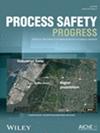案例研究:研究A2 Pasquill大气条件对重质气体扩散模拟的影响
IF 1
4区 工程技术
Q4 ENGINEERING, CHEMICAL
引用次数: 0
摘要
本研究为除典型的F2和D5外,在弥散模拟中加入A2 Pasquill天气参数提供了一个站得住的论据。A2参数保守地模拟了集中在地面的气体释放,从而允许对排放口高度、周围结构/设备和安全措施进行更稳健的设计。在这项调查中,在PHAST(过程危害分析软件工具)8.6版本中开发了12个常见碳氢化合物和芳香族气体混合物的案例研究。每种情况都改变温度、释放压力(速度)和分子量(MW),以模拟可能倾向于地面的致密气体。随后,每个案例研究都使用Pasquill大气稳定性等级A2、D5和F2进行建模,以可视化不同天气条件下密集气体的扩散,并评估哪种天气参数最能包括高严重情景。结果表明,在A2大气条件下,密集(比露点冷,重,加压)气体产生的地面浓度最高,释放温度越低于混合物的露点,混合物在地面的浓度越大。讨论了后果建模建议,并讨论了需要使用保守模型估计地面浓度的特定气体特性。本文章由计算机程序翻译,如有差异,请以英文原文为准。
Case study: Investigating the effect of the A2 Pasquill atmospheric condition on the dispersion modeling of heavy gases
Abstract This study provides a defensible argument for the inclusion of the A2 Pasquill weather parameter in dispersion modeling, in addition to the typical F2 and D5. The A2 parameter conservatively models gas releases that concentrate at ground level, thus allowing for a more robust design of vent heights, surrounding structures/equipment and safety measures. For this investigation, 12 case studies of common hydrocarbon and aromatic gas mixtures were developed in PHAST (Process Hazard Analysis Software Tool) version 8.6. Each case varied in temperature, release pressure (velocity), and molecular weight (MW) to simulate dense gases likely to tend toward ground level. Subsequently, each case study was modeled with the Pasquill Atmospheric Stability Classes, A2, D5, and F2, to visualize the dispersion of dense gases under different weather conditions and evaluate which weather parameter would be most inclusive of high‐severity scenarios. Results demonstrate that dense (colder than dew point, heavy, pressurized) gases yield highest ground‐level concentrations using the A2 atmospheric condition, and the further the release temperature falls below the mixture's dew point, the greater the mixture concentration at ground level. Consequence modeling recommendations are discussed, and specific gas properties are addressed that necessitate using a model that is conservative in its estimation of ground‐level concentrations.
求助全文
通过发布文献求助,成功后即可免费获取论文全文。
去求助
来源期刊

Process Safety Progress
工程技术-工程:化工
CiteScore
2.20
自引率
10.00%
发文量
99
审稿时长
6-12 weeks
期刊介绍:
Process Safety Progress covers process safety for engineering professionals. It addresses such topics as incident investigations/case histories, hazardous chemicals management, hazardous leaks prevention, risk assessment, process hazards evaluation, industrial hygiene, fire and explosion analysis, preventive maintenance, vapor cloud dispersion, and regulatory compliance, training, education, and other areas in process safety and loss prevention, including emerging concerns like plant and/or process security. Papers from the annual Loss Prevention Symposium and other AIChE safety conferences are automatically considered for publication, but unsolicited papers, particularly those addressing process safety issues in emerging technologies and industries are encouraged and evaluated equally.
 求助内容:
求助内容: 应助结果提醒方式:
应助结果提醒方式:


